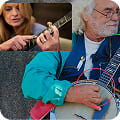Multi-Style Cello with Mike Block


Preview this school

Master the Cello with Mike
Each lesson builds on the last, taking you from zero to hero!

Master the cello with Grammy award winner Mike Block. Over 300 progressively paced lessons from beginner through advanced, covering traditional and modern techniques across multiple genres such as classical, jazz, and bluegrass.
Beginner
Learn cello technique basics, posture, bowing, scales, improvisation, and fun beginner tunes step by step.
Intermediate
Build strength, flexibility & freedom with expanded scales, shifting, pizzicato and thumb position.
Advanced
Level up with advanced scales, arpeggios, thumb work & expressive vibrato.
Bluegrass
Explore bluegrass style through classic tunes, bowing, improvisation, and comping techniques.
Jazz
Learn jazz basics through tunes, improvisation, chord scales, and walking bass techniques.
Classical
Discover classical phrasing, tone, and historical context through curated pieces and exercises.
Rhythmic & Chordal Playing
Develop groove, harmony, and coordination through chopping, chords, and vocal exercises.
Contemporary Cello Etudes
Explore 28 creative etudes by top modern artists—students receive Mike's printed book free with enrollment.
Cello Reference Topics
Learn how to choose gear, travel smart, and build effective practice habits.
30 Day Challenge
Get Personal Feedback with Video Exchange
Get custom video lessons from your instructor by sending a video of your playing.

How It Works?

1. Submit Your Video
Record and upload directly through our platform. No technical skills required.

2. Get Expert Feedback
Receive personal video responses from Mike Block with tips to improve!

3. Learn from Community
Browse exchanges from other students to learn from their questions.
About Multi-Style Cello with Mike Block
Mike Block has taken his entire knowledge of playing cello and poured it into a comprehensive video library that includes hundreds of lessons in a wide variety of styles. Subscribers get unlimited access to all online cello lessons, supplemented by backing tracks and other study materials. Plus there's special guests, exclusive interviews, and a community of cello enthusiasts from all over the world. What ultimately sets these cello lessons apart from other online offerings however, is the ability to submit a video using the ArtistWorks Video Exchange® learning platform. Mike reviews each submission and records a video response where he offers tips and techniques to practice. All students can access Mike's Video Exchange library, which is always expanding and may contain the key to unlock your own playing.
About Mike Block
Mike Block is a pioneering multi-style cellist and composer, who first joined Yo-Yo Ma’s Silk Road Ensemble while still studying at the Juilliard School, where he later earned his Master's Degree. Known for the unorthodox style of playing cello while standing up, Mike was the first standing cellist to perform at Carnegie Hall, and has since appeared on TV shows that include "Late Night with Conan O’Brian", "Regis and Kelly", NBC’s 30 Rock, and the CBS "Early Show". He has served as music director for musicians as diverse as Yo-Yo Ma, Bobby McFerrin, Marcus Printup, and Damian Woetzel (Principal at NYC Ballet) among others. He's also performed and recorded with a wide range of musicians including Stevie Wonder, Allison Krauss, Edgar Meyer, Mark O’Connor, Mike Marshall, Darol Anger, Zakir Hussain, Tim O’Brien, Lenny Kravitz, Shakira, and many others. Mike has also released several albums of original material that showcase his virtuoso cello playing and diverse interests in music.
What students are saying!
Just started
I started on cello with an excellent teacher 25 years ago. Work commitments prevented me from regular practice so I stopped. Having recently retired, I decided to take up my cello ...
Mike Block Cello - A Gold Medal From Me!
Mike Block's cello course on artistworks, has been, for me, the most useful, enjoyable and productive teaching and learning model I have ever encountered. The planning and expertis...
Exceptional instructor, great experience
I have been playing cello for over two years. I started Mike Block's course from the first day I picked up the instrument, and I have to say I couldn't ask for a better online lear...
So helpful!!
Taking the classes you get to learn different techniques of how to play and it’s easy to digest the information! You can even slow it down to make it easier. Definitely would recom...
What a great place to learn cello!
Mike Block + ArtistWorks is an amazing way to learn cello. Mike gives clear, concise feedback that keeps me motivated to learn. He keeps it positive, but also offers real suggestio...
cello style with Mike
Thank you for the comprehensive wed site for learning new ways to play my cello. It is all very informative, clear and concise. I am enjoying it very much. and excited about learn ...
Best Teacher Ever!
I really like Mike Block. I've taken from several teachers and he is THE BEST. He teaches you how to play the music, not mearly playing notes. I love how he plays along with me so ...
Mike Block is a great
Mike Block is a great teacher and artist. I am very pleased to have landed on his ArtistWorks cello course during my search for an instructor for my beginner steps on the cello.
Cello
I'm having a wonderful time learning the cello with artist works..have really seen an improvement
Awesome teacher and course
Just started and already know this is going to be the perfect course for me and Mike Block the perfect teacher for me! His versatile, friendly and unpretentious love of music is wh...
5.0 Rating

